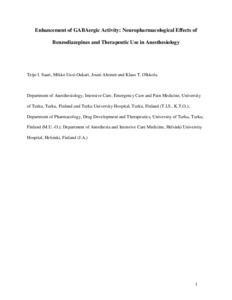Enhancement of GABAergic activity:neuropharmacological effects of benzodiazepines and therapeutic use in anaesthesiology
Saari TI; Uusi-Oukari M; Ahonen J; Olkkola KT
https://urn.fi/URN:NBN:fi-fe2021042719850
Tiivistelmä
GABA is the major inhibitory neurotransmitter in the central nervous
system (CNS). The type A GABA receptor (GABAAR) system is the primary
pharmacological target for many drugs used in clinical anesthesia. The
α1, β2, and γ2 subunit-containing GABAARs located in the various parts
of CNS are thought to be involved in versatile effects caused by
inhaled anesthetics and classic benzodiazepines (BZD), both of which are
widely used in clinical anesthesiology. During the past decade, the
emergence of tonic inhibitory conductance in extrasynaptic GABAARs has
coincided with evidence showing that these receptors are highly
sensitive to the sedatives and hypnotics used in anesthesia. Anesthetic
enhancement of tonic GABAergic inhibition seems to be preferentially
increased in regions shown to be important in controlling memory,
awareness, and sleep. This review focuses on the physiology of the
GABAARs and the pharmacological properties of clinically used BZDs.
Although classic BZDs are widely used in anesthesiological practice,
there is a constant need for new drugs with more favorable
pharmacokinetic and pharmacodynamic effects and fewer side effects. New
hypnotics are currently developed, and promising results for one of
these, the GABAAR agonist remimazolam, have recently been published.
Kokoelmat
- Rinnakkaistallenteet [27094]
